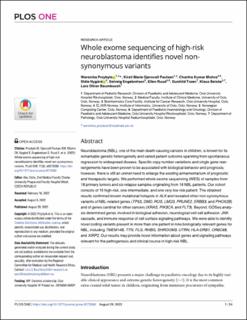Whole exome sequencing of high-risk neuroblastoma identifies novel non-synonymous variants
| dc.contributor.author | Przybyla, Weronika | |
| dc.contributor.author | Gjersvoll Paulsen, Kirsti Marie | |
| dc.contributor.author | Mishra, Charitra Kumar | |
| dc.contributor.author | Nygård, Ståle | |
| dc.contributor.author | Engebretsen, Solveig | |
| dc.contributor.author | Ruud, Ellen | |
| dc.contributor.author | Trøen, Gunhild | |
| dc.contributor.author | Beiske, Klaus | |
| dc.contributor.author | Baumbusch, Lars Oliver | |
| dc.date.accessioned | 2023-03-03T15:12:21Z | |
| dc.date.available | 2023-03-03T15:12:21Z | |
| dc.date.created | 2022-09-13T12:24:10Z | |
| dc.date.issued | 2022 | |
| dc.identifier.citation | PLOS ONE. 2022, 17 (8), . | en_US |
| dc.identifier.issn | 1932-6203 | |
| dc.identifier.uri | https://hdl.handle.net/11250/3055835 | |
| dc.description.abstract | Neuroblastoma (NBL), one of the main death-causing cancers in children, is known for its remarkable genetic heterogeneity and varied patient outcome spanning from spontaneous regression to widespread disease. Specific copy number variations and single gene rearrangements have been proven to be associated with biological behavior and prognosis; however, there is still an unmet need to enlarge the existing armamentarium of prognostic and therapeutic targets. We performed whole exome sequencing (WES) of samples from 18 primary tumors and six relapse samples originating from 18 NBL patients. Our cohort consists of 16 high-risk, one intermediate, and one very low risk patient. The obtained results confirmed known mutational hotspots in ALK and revealed other non-synonymous variants of NBL-related genes (TP53, DMD, ROS, LMO3, PRUNE2, ERBB3, and PHOX2B) and of genes cardinal for other cancers (KRAS, PIK3CA, and FLT3). Beyond, GOSeq analysis determined genes involved in biological adhesion, neurological cell-cell adhesion, JNK cascade, and immune response of cell surface signaling pathways. We were able to identify novel coding variants present in more than one patient in nine biologically relevant genes for NBL, including TMEM14B, TTN, FLG, RHBG, SHROOM3, UTRN, HLA-DRB1, OR6C68, and XIRP2. Our results may provide novel information about genes and signaling pathways relevant for the pathogenesis and clinical course in high-risk NBL. | |
| dc.language.iso | eng | en_US |
| dc.rights | Navngivelse-Ikkekommersiell-DelPåSammeVilkår 4.0 Internasjonal | * |
| dc.rights.uri | http://creativecommons.org/licenses/by-nc-sa/4.0/deed.no | * |
| dc.title | Whole exome sequencing of high-risk neuroblastoma identifies novel non-synonymous variants | en_US |
| dc.title.alternative | Whole exome sequencing of high-risk neuroblastoma identifies novel non-synonymous variants | en_US |
| dc.type | Journal article | en_US |
| dc.type | Peer reviewed | en_US |
| dc.description.version | publishedVersion | |
| cristin.ispublished | true | |
| cristin.fulltext | original | |
| cristin.qualitycode | 1 | |
| dc.identifier.doi | 10.1371/journal.pone.0273280 | |
| dc.identifier.cristin | 2051170 | |
| dc.source.journal | PLOS ONE | en_US |
| dc.source.volume | 17 | en_US |
| dc.source.issue | 8 | en_US |
| dc.source.pagenumber | 24 | en_US |
Tilhørende fil(er)
Denne innførselen finnes i følgende samling(er)
-
Publikasjoner fra Cristin [284]
-
Vitenskapelige tidsskriftartikler og konferanseartikler med fagfellevurdering (NVI-kategori) [215]
Vitenskapelige tidsskriftartikler og konferanseartikler med fagfellevurdering (NVI-kategori)

